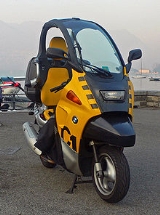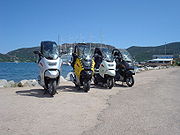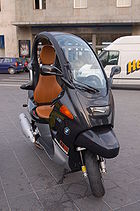
BMW C1
Encyclopedia
The BMW C1 is an enclosed scooter
manufactured by Bertone for BMW
.
 Two models were manufactured. The '125' model has a 124 cc capacity four valve, four-stroke, water-cooled, fuel injected engine producing 15 bhp. The '200' model has a 176 cc engine producing 18 bhp. Both engines were manufactured by Rotax
Two models were manufactured. The '125' model has a 124 cc capacity four valve, four-stroke, water-cooled, fuel injected engine producing 15 bhp. The '200' model has a 176 cc engine producing 18 bhp. Both engines were manufactured by Rotax
and include a CVT
gearbox.
BMW-supplied accessory options
could be added at point of sale or sometimes retrofitted such as:
Three different options were available for the space behind the rider, all of them with matching key/lock and could be swapped out quickly:
BMW build quality is particularly noticeable in the pillion seat after market kit. It provides not only the seat itself, but warning/safety stickers, foot pegs and a kit for adjusting the headlights tilt angle as the attitude of the bike changes with different payloads.
A windscreen wiper with washer fluid completes the 'two wheeled car feel' and together with the roof/passenger cell creates a bike which has a higher centre of gravity than just about any other. In addition the rider is held upright against the seat's backrest by a four-point seat-belt. This makes handling at slow speed, and in particular taking corners in tight spaces or manoeuvring the bike at walking pace difficult until experience is acquired. The C1 weighed approximately 185 kg (407.9 lb) with a 40/60 weight distribution towards the back.
.jpg)
 BMW's intention with the C1 was to appeal to car drivers in crowded city streets. The idea was to offer the convenience of a scooter or motorbike but without many of the associated dangers or hassles. The C1's most innovative design feature was its emphasis on safety.
BMW's intention with the C1 was to appeal to car drivers in crowded city streets. The idea was to offer the convenience of a scooter or motorbike but without many of the associated dangers or hassles. The C1's most innovative design feature was its emphasis on safety.
BMW added passive safety and car-like crash testing to the scooter. It claimed that in a head-on collision, the C1 offered a standard of accident protection comparable to a European compact car. That was the prime marketing strategy to convert car buyers; the C1 was claimed to be so safe that the rider did not need to wear a helmet to ride it. This was achieved by using two shoulder-height roll bars, a crumple zone around the front wheel and an aluminium roll cage creating a car-like safety cell. It also had twin seatbelts reminiscent of an aviation style four-point harness to keep the rider in place.
Many countries deemed the use of seatbelts in conjunction with wearing a helmet to be unsafe. The added strain on the riders neck from the added weight of the helmet could cause significant injury to the restrained rider even in a low speed head-on collision.
Germany, Switzerland, Italy, France, Israel and Spain authorities were quick to allow an exception to the helmet law for the C1. However, poor C1 sales in the United Kingdom may in part be attributable to the British government's refusal of BMW's request to change helmet regulations for C1 riders.
Another country that requires C1 riders to wear a helmet is Sweden, although wearing the seat-belts is voluntary.
After selling 10,614 units in 2001, BMW only sold 2,000 units in 2002, and ceased production of the C1 in October 2002. It was never made available in the USA.
The C1-E uses components supplied by electric scooter manufacturer Vectrix
and is powered by a lithium-ion battery.
Scooter (motorcycle)
A scooter is a motorcycle with step-through frame and a platform for the operator's feet. Elements of scooter design have been present in some of the earliest motorcycles, and motorcycles identifiable as scooters have been made from 1914 or earlier...
manufactured by Bertone for BMW
BMW Motorrad
BMW Motorrad is the motorcycle brand of the German company BMW, part of its Corporate and Brand Development division. The current General Director of the unit is Hendrik von Kuenheim....
.
Models and options

Rotax
BRP-Powertrain GmbH & Co KG , commonly known simply as Rotax, is an Austrian engine manufacturer. It develops and produces four-stroke and advanced two-stroke engines for Bombardier Recreational Products products as well as for motorcycles, karts,...
and include a CVT
Continuously variable transmission
A continuously variable transmission is a transmission that can change steplessly through an infinite number of effective gear ratios between maximum and minimum values. This contrasts with other mechanical transmissions that offer a fixed number of gear ratios...
gearbox.
BMW-supplied accessory options
Motorcycle accessories
Motorcycle accessories are features and accessories selected by a motorcycle owner to enhance safety, performance, or comfort, and may include anything from mobile electronics to sidecars and trailers...
could be added at point of sale or sometimes retrofitted such as:
- Anti-lock brakes (ABS)Anti-lock braking systemAn anti-lock braking system is a safety system that allows the wheels on a motor vehicle to continue interacting tractively with the road surface as directed by driver steering inputs while braking, preventing the wheels from locking up and therefore avoiding skidding.An ABS generally offers...
- 'Fun Audio System' (music systemCar audioCar audio/video , auto radio, mobile audio, 12-volt and other terms are used to describe the sound or video system fitted in an automobile. While 12-volt audio and video systems are also used, marketed, or manufactured for marine, aviation, and buses, this article focuses on cars as the most common...
, volume linked to speed) - Interior reading light
- BMW ImmobilizerImmobiliserAn immobiliser or immobilizer is an electronic device fitted to an automobile which prevents the engine from running unless the correct key is present...
alarm system - Lockable glove boxGlove compartmentA glove compartment or glovebox, also known as a little cupboard, is a compartment built into the dashboard, located over the front-seat passenger's footwell in an automobile, often used for miscellaneous storage. The name derives from the original purpose of the compartment, to store gloves...
with power socket - SunroofSunroofAn automotive sunroof is a fixed or operable opening in an automobile roof which allows light and/or fresh air to enter the passenger compartment. Sunroofs may be manually operated or motor driven, and are available in many shapes, sizes and styles...
(as opposed to the standard 'hard top') - Heated grips and/or seat
Three different options were available for the space behind the rider, all of them with matching key/lock and could be swapped out quickly:
- A large, lockable external storage box
- Luggage rack
- Pillion seatPillionA pillion is a mostly British English term for a secondary pad, cushion, or seat behind the main seat or saddle on a horse, motorcycle, bicycle or moped...
BMW build quality is particularly noticeable in the pillion seat after market kit. It provides not only the seat itself, but warning/safety stickers, foot pegs and a kit for adjusting the headlights tilt angle as the attitude of the bike changes with different payloads.
A windscreen wiper with washer fluid completes the 'two wheeled car feel' and together with the roof/passenger cell creates a bike which has a higher centre of gravity than just about any other. In addition the rider is held upright against the seat's backrest by a four-point seat-belt. This makes handling at slow speed, and in particular taking corners in tight spaces or manoeuvring the bike at walking pace difficult until experience is acquired. The C1 weighed approximately 185 kg (407.9 lb) with a 40/60 weight distribution towards the back.
History
.jpg)

BMW added passive safety and car-like crash testing to the scooter. It claimed that in a head-on collision, the C1 offered a standard of accident protection comparable to a European compact car. That was the prime marketing strategy to convert car buyers; the C1 was claimed to be so safe that the rider did not need to wear a helmet to ride it. This was achieved by using two shoulder-height roll bars, a crumple zone around the front wheel and an aluminium roll cage creating a car-like safety cell. It also had twin seatbelts reminiscent of an aviation style four-point harness to keep the rider in place.
Many countries deemed the use of seatbelts in conjunction with wearing a helmet to be unsafe. The added strain on the riders neck from the added weight of the helmet could cause significant injury to the restrained rider even in a low speed head-on collision.
Germany, Switzerland, Italy, France, Israel and Spain authorities were quick to allow an exception to the helmet law for the C1. However, poor C1 sales in the United Kingdom may in part be attributable to the British government's refusal of BMW's request to change helmet regulations for C1 riders.
Another country that requires C1 riders to wear a helmet is Sweden, although wearing the seat-belts is voluntary.
After selling 10,614 units in 2001, BMW only sold 2,000 units in 2002, and ceased production of the C1 in October 2002. It was never made available in the USA.
C1-E electric version
In 2009 BMW used the same layout for the C1-E, an electric scooter concept vehicle that it developed as part of the European safety project eSUM ("European Safer Urban Motorcycling").The C1-E uses components supplied by electric scooter manufacturer Vectrix
Vectrix
Vectrix is an electric vehicle company based in Middletown, Rhode Island, United States, with research and development facilities in New Bedford, Massachusetts...
and is powered by a lithium-ion battery.
External links
- Making of BMW C1, Makar Verigo. Photos and CAD visualisations.
- Jeremy Clarkson review of the C1. Times Apr 2000. "... the only bikes worth having cost £12,000 or more."

